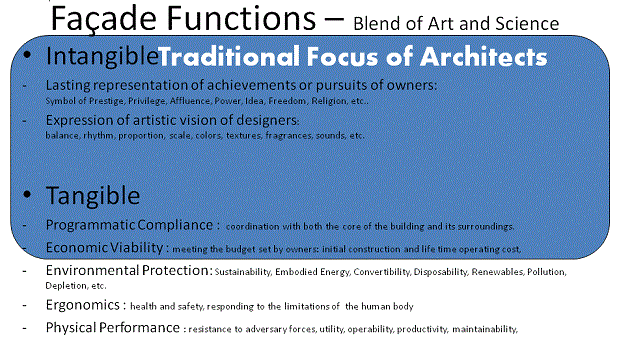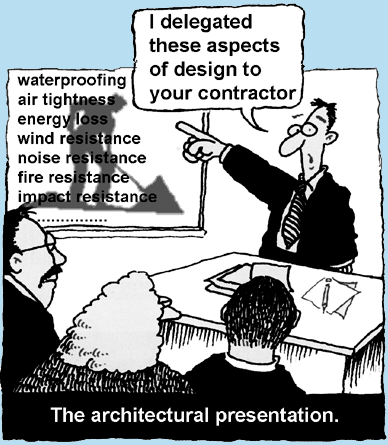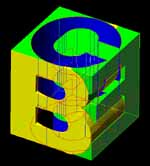Table of Contents
The results of the survey - introduction
Thank you for your participation in the trivia posted online earlier. The waiting is over! I will show the results of the survey and provide the expanded responses to the questions in this and the following emails.
As a reminder: I developed several sets of questions originally intended as surveys to test the prospective audience and adjust the level of technical presentation to their needs. I posted five of them in the form of trivia for those of you who love testing their skills and comparing against others. More will come as the time permits.
The first trivia set titled "Facade Engineering -Elementary Scientific Literacy for Architects " was an overwhelming success judging by its popularity. It consists of eight questions, and the correct answers are available immediately upon response to each question. Users could access expanded explanations upon completion of the first set.
The information about the trivia was distributed by this newsletter, so it is probably fair to say that the respondents were generally interested and having higher than average knowledge of sciences and technology of building enclosures.
Today (this is a copy of the newsletter sent in the middle of August) I present three "wind" questions from the "Facade Engineering -Elementary Scientific Literacy for Architects " trivia. They were intended to test the intuitive understanding of the wind forces among architects.
"How many times a wind pressure changes when the wind speed doubles?"
There were four choices available, and you gave the following responses:
response |
percent |
One and half time |
4.6 |
Two times |
12.3 |
Four times |
76.9 |
Eight times |
6.2 |
The correct answer was: Doubling the wind velocity increases the pressure four times. The relationship is square.
Here is a short explanation of the answer.
This principle, apart from being fairly intuitive for sailors, pilots, CFD modelers, and other folks who deal often with the wind, is specifically codified for the construction sector by references and copies of the language of the standard published by the American Society of Civil Engineers and the Structural Engineering Institute named "ASCE/SEI 7 Minimum Design Loads for Buildings and Other Structures" in local building codes. One chapter is devoted to the wind. The equation 6-15 in par. 6.5.10 states "Velocity pressure, q,, evaluated at height z shall be calculated by the following equation: qz = 0.00256 *Kz * Kzt * Kd * V^2 * I(lb//ft2), " where V is the basic wind speed, according to p.6.3 and all other components of the equation are coefficients.
This is basically saying that the pressure equals square velocity times miscellaneous coefficients. Therefore, when the wind speed doubles, the pressure quadruples because the relationship is square.
I asked a friend of mine who took the survey (who is an architect but runs a successful building enclosure consulting firm) how he found a response to this question. He said he didn't know the answer off the top of his head but he looked at a handy windload pressure conversion charts to figure out the answer by comparing readings from different rows. Congratulations!
Why would anybody care?
This quiz was intended for architects. Unless they design military bunkers like my old Soviet-era university professor, some people believe that they may need to gain at least an intuitive understanding of the wind and the forces it generates in the cladding. The practical application was exemplified in the question #2 below.
You found a two-way spanning façade component in a manufacturer’s catalog. You like it and plan to use it on your façade but the printed wind chart ends on a roughly half of the wind speed required for your project. How many times you would need to decrease spacing of its fasteners applied in a rectangular pattern, in order to use it on your project?"
There were four choices available, and your responses were following:
response |
percent |
One time |
4.9 |
Two times |
50.8 |
Four times |
36.1 |
Eight times |
8.2 |
The correct answer to the question was: Two times. Doubling the wind velocity quadruples the wind pressure, and halving the spacing of the rectangular pattern quadruples the number of fasteners.
The question requires the practical application of the rule exemplified in the question #1. It was based on an hypothetical architectural dilemma: there is a cladding component fastened in rectangular pattern (e.g. a stucco lath, a metal panel, or a flat stock of a rigid insulation), but the project's wind velocity is two times the wind velocity for which the fastening was originally engineered (e.g. you used it on a 70mph project in the past, and now you would like to use it in a 140mph area). The circumstances and proportions may vary, but the intuitive understanding of the relationship is important.
We just learned that almost 77% of respondents knew the correct answer to the first question: doubling the wind velocity quadruples the wind pressure.
However, we must have lost one third of them on the exercise requiring some spatial imagination: halving the spacing of the rectangular pattern quadruples the number of fasteners.
(This is an oversimplified example. There are some other considerations that may apply to the situation like that, besides the strictly mathematical multiplication of the velocities and fastening points. Some of these items are discussed in my seminar titled "Curtain Walls.")
"How a wind pressure acting on the cladding changes when the wind velocity parallel to façade increases?
(I know, we skipped several questions between two and eight but we only deal with the wind today. The other questions will be explained in the following emails once I find some time. )
There were three choices available, and your responses were following:
response |
percent |
Increases |
49 |
Decreases |
35.3 |
Does not change |
15.7 |
Only 1/3 of the respondents picked the correct answer: The pressure DECREASES. And it decreases a lot. The wind pressure decreases exponentially according to the Bernoulli's Principle. I am sure you already googled the Bernoulli's principle once I gave you the right answer when you responded to the trivia.
For the mental illustration you can perform an experiment: Grab an illustrated magazine, e.g. The Architectural Record. Bend the two covers over, and blow the air from your mouth between the two covers. You will notice that the pages move closer, like attracted to each other. This is the same what happens to cladding between two buildings. Here is the similar experiment scanned from page B11 of the great Rod Machado's "Private Pilot Handbook."
This is an interesting, elementary question that I typically explain in my lecture "Principles of Facade Design." Again, it is fairly intuitive for sailors, pilots, CFD modelers, and other folks who deal often with wind. The response may serve as the useful illustration of the confusion between the direction of the wind flow and its pressure. Architects are taught that a cladding reacts to the perpendicular component of the wind force. Therefore, they assume that if the wind is parallel to the facade, the component is zero. Those who intuitively sensed that it doesn't make sense, decided that the pressure must INCREASE, which is the opposite to what actually happens.
I remember one senior architect attending my seminars who was surprised by photographs which I presented. The photographs illustrated the wind damage to the fenestration that I investigated several years ago. He was surprised that the glazing and its framing were blown and bend OUTWARD. For all these years he believed that a facade experiences the peak wind pressure differential pushing the glazing inwards only. Don't laugh; someone lives in the buildings he designed...
The three questions were intended to test the intuitive understanding of the wind forces among architects. Architects design our buildings, and the wind is one of the main adversaries of the building enclosures. The general public (e.g. all the building owners I talked to so far) reasonably expects that they should at least know whether it decreases or increases and in what proportion. Unfortunately, only 54.33% of the respondents chose the correct responses.
Does it mean that 45.67% were dead wrong. ? I would rather say that it is the general public that is wrong in assuming architects should be familiar with building enclosure sciences and technology. Traditionally, architects concentrate on intangible, programmatic, and economic criteria of buildings, as opposed to their tangible functionality as explained in the chart from my seminar " Principles of Facade Engineering" copied below. Some architects hire consultants, such as myself, to deal with the physical performance of buildings, and to free their time for more creative tasks.

However, other architects may delegate the physical performance design to their contractors, and the results may vary:

|



